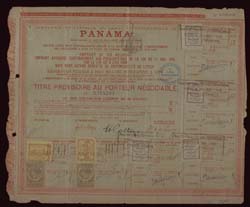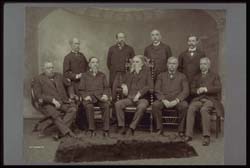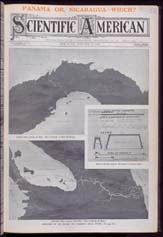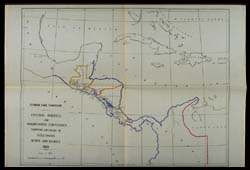
“While not possessing any single feature
better than that of some other route . . . the Panama route has many less
bad features than any of the others.” — George S. Morison,
engineer and Isthmian Canal Commission member, 1903
|
How Did Panama Become Independent?
In 1903, French canal builders agreed to
sell their stake in the bankrupt Panama venture to the United States for
$40 million. Colombia, because of its sovereignty over Panama, expected
part of the payment, but felt the price was too low. Unwilling to have
the sale jeopardized and recognizing Panama’s desire for independence,
the United States quietly encouraged Panama to rebel. The ensuing three-day-long
revolution, under the watchful eye of two U.S. gunboats, created the Republic
of Panama. A few days later, the United States and Panama signed a treaty
to build the canal. |
|
Selecting the canal route was primarily
an engineering issue, but individuals outside of the profession determined
its final site.
Frenchman Ferdinand de Lesseps downplayed
challenging terrain, torrential rains, and rampant disease in his attempt
to build a sea-level canal across Panama. When that effort failed, Americans
debated whether they should continue the French work or start fresh elsewhere
in Panama or Nicaragua. Sovereignty was also a factor; at the time, Panama
was part of Colombia, which held legal jurisdiction over the French canal
lease.
Although many in Congress and two presidential
canal commissions favored Nicaragua, President Theodore Roosevelt, convinced
of Panama’s technical merits, decided the canal would be built there.
 On
December 7, 1880, the Compagnie Universelle du Canal Interocéanique
de Panama began selling stock to pay for canal construction. A few years
later, the company sold lottery bonds like this one to raise additional
funds. Investors, having lost faith in Lesseps and his project, did not
buy many, and bankruptcy soon followed. In 1894, the company was reorganized
as the Compagnie Nouvelle du Canal de Panama. It, too, eventually failed. On
December 7, 1880, the Compagnie Universelle du Canal Interocéanique
de Panama began selling stock to pay for canal construction. A few years
later, the company sold lottery bonds like this one to raise additional
funds. Investors, having lost faith in Lesseps and his project, did not
buy many, and bankruptcy soon followed. In 1894, the company was reorganized
as the Compagnie Nouvelle du Canal de Panama. It, too, eventually failed.
 At
the request of Congress in 1899, President William McKinley appointed a
commission of military officers, government officials, and engineers to
determine the cost and most practical route of constructing a canal under
U.S. control and ownership. Seated in the front row at the far left is
renowned engineer George S. Morison, the commission’s primary proponent
of a Panama route. At
the request of Congress in 1899, President William McKinley appointed a
commission of military officers, government officials, and engineers to
determine the cost and most practical route of constructing a canal under
U.S. control and ownership. Seated in the front row at the far left is
renowned engineer George S. Morison, the commission’s primary proponent
of a Panama route.
 
Most of the members of the Isthmian Canal
Commission favored a canal across Nicaragua. Civil engineer George S. Morison
wrote the minority views in the Commission’s 1901 report to Congress. He
sent this letter to President Theodore Roosevelt explaining the technical
reasons for his preference for Panama. The letter helped persuade Roosevelt
that Panama was the best route.
 The
authors of this Scientific American article concluded that construction
would be feasible in both Nicaragua and Panama. A Nicaraguan canal would
be closer to the United States but four times longer than one in Panama. The
authors of this Scientific American article concluded that construction
would be feasible in both Nicaragua and Panama. A Nicaraguan canal would
be closer to the United States but four times longer than one in Panama.

Proponents of a Panama canal route emphasized
the threat of active volcanoes and earthquakes in Nicaragua, neither of
which plagued Panama.
|


